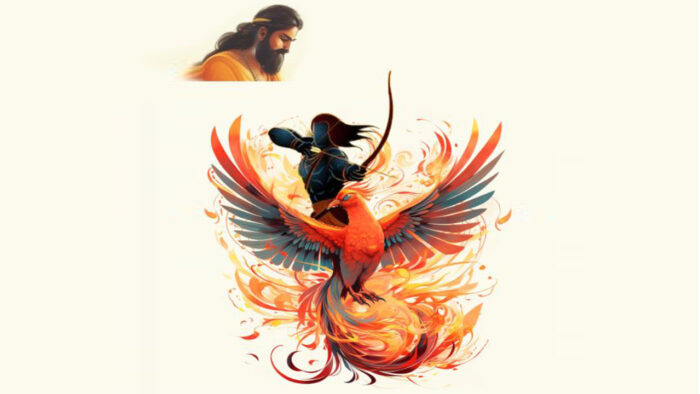Ayodhya, the sacred city, was brimming with excitement as it prepared to extend a joyous welcome to Purushottama, the esteemed Shri Rama, signifying the end of a protracted period of eager anticipation. Following a prolonged exile lasting five and a half centuries, Shri Rama at last made his triumphant return to his homeland.
This isn’t a run-of-the-mill event relegated to the sidelines amid various other sacred occurrences. A mere decade ago, the political and collective mindset of Bharat’s people differed significantly. The sheer grandeur and reverence that accompanied Sri Rama’s return to Ayodhya, amidst jubilant celebrations, would have been unimaginable to many.
This event transcends mere structural changes over time; it delves deep into the narrative of thousands of lives sacrificed over the past 500 years, all in the name of devotion to Ram. For nearly six decades, the dreams of countless devotees lay shattered. The sacrifices made by these fervent Ram Bhakts seemed inconsequential to some influential leaders of post-independent India. Millions of devotees worldwide carried the scars of neglect, as their sacrifices were seemingly dismissed.
Visitors to Shri Rama’s birthplace, until just a couple of years ago, found themselves overwhelmed with a sense of helplessness, frustration, and despair due to the dire state of political affairs. Ram Lalla used to be in a small and torn tent in his own birth place. After immense struggle, people got permission to worship Rama in this torn tent without any permission to make upgrades to the tent. The condition of Ram bhakts was so dire that any inkling of peaceful protest faced severe condemnation from governing bodies. It was as if Shri Rama belonged to a distant realm, and devotees were desperately trying to integrate him into Ayodhya.
On the flip side, the descendants of Rama, known as Suryavamshis, and the lineage of Raghuvamsas are experiencing genuine joy as their longstanding vows tied to the reconstruction of Shri Ram Janmabhoomi are finally being fulfilled. While it’s unfortunate that several generations since the 1500s harbored dreams of restoring Shri Rama’s temple aren’t alive anymore, there’s now a community of Suryavamshi Kshatriyas joyously donning turbans from the auspicious date of January 22, 2024. Some individuals have also broken their vows of silence, prompted by Rama’s return to their hometown. The sentiments are vast, and the sense of fulfillment is overwhelming for Ram bhakts across the globe.
Bharat of Yesteryears…
Flipping through the pages of Bharat’s history before the last 1300 years, we encounter a golden era untouched by the oppressions of invas
ions and colonialism. The country’s wealth and prosperity were renowned globally. Bharat served as a hub for educational tourism, attracting students from diverse corners of the world, including China and Europe. The wisdom embedded in our Vedas and scriptures, coupled with the scientific acumen of our ancestors in fields like medicine, astronomy, and astrology, was not only accurate but also highly revered worldwide. This expertise drew scholars and learners from across the globe.
Technologically advanced, India boasted ancient knowledge of metallurgy. Susrutha an Ayurvedic doctor predating 2000 years, performed plastic surgeries and intricate organ surgeries, as documented in his works. The Varaha avataram of Shri Maha Vishnu asserted the earth’s spherical nature thousands of years ago, contrasting with the struggles faced by the Western scholars, a few hundred years back, against the Church’s opposition to establishing this fact. Our ancestors adeptly positioned planets and predicted their movements and impacts, encapsulated in the Panchangam, centuries before today’s AccuWeather app.
In terms of trade, India contributed a staggering 35% to the global GDP before the advent of the British era, dominating maritime trade for centuries while the rest of the world navigated the complexities of civilization. Even in the 1700s, India hosted over five lakh traditional Gurukul schools, offering residential education to students from diverse communities.
The agonizing reality lies in the systematic plundering of our riches and destruction of our way of life by numerous invaders and marauders.
The arrival of Shri Rama and the Bharat of Tomorrow…
The avatar of Shri Rama holds significant importance among the Dasha avatarams of Maha Vishnu. This avatar represents Maha Vishnu taking the form of Shri Rama, leading a full-fledged human life facing both glories and agonies that would come to any average human. The merits and exemplifications of this great avatar stem from how Shri Rama managed various difficult situations as a Kshatriya king, standing by dharma throughout his lifetime. He focused on the greater well-being of the people, society, and mankind. Shri Rama triumphed over these hardships. Similarly, our country, though oppressed for several centuries through occupations and destructions, is finally getting back to its roots.
Certainly, the colonial dust is beginning to wade and wither away gradually with the advent of a new and fresh idea of Bharat, aiming to revive the erstwhile Bharat and bring back that heritage that is truly ours. For a country to grow and flourish, it is important to protect and nurture its heritage. According to Bhagavatha Puranam, the duration of each yugam goes for lakhs of years (For example: Kali yuga duration is 4,20,000 years). However, Bharat has an evidence-based history for more than 11000 years; that said, historians and archaeologists continue to increase the time period of Bharat’s civilization with each new finding in one region or the other. Bharat is the only ancient living civilization in the world that lives and breathes our rich cultural heritage to date. Hence, to make Bharat the power center, it is essential to revive the ancient Bharat’s heritage and encourage people to leave their colonial pasts behind, actively pursuing their lives in alignment with our sacred heritage. The construction of Ram Lalla temple and the consecration ceremony mark the new era for Bharat as we begin the journey towards writing our own history for the first time in a thousand years. A journey towards Bharat becoming an inclusive and sustainable superpower where all of us across the world gain access to everything with responsibility and without unnecessary restraints.
This event serves as a testament to the resurgence of the ancient and prosperous Bharat, a tangible symbol of decolonization, and the inception of a new journey toward Bharat reclaiming its position as the Vishwaguru. Jai Shri Ram. Har Har Maha Dev!
Feature Image Credit: Harecharan Sukumar
Disclaimer: The opinions expressed in this article belong to the author. Indic Today is neither responsible nor liable for the accuracy, completeness, suitability, or validity of any information in the article.








